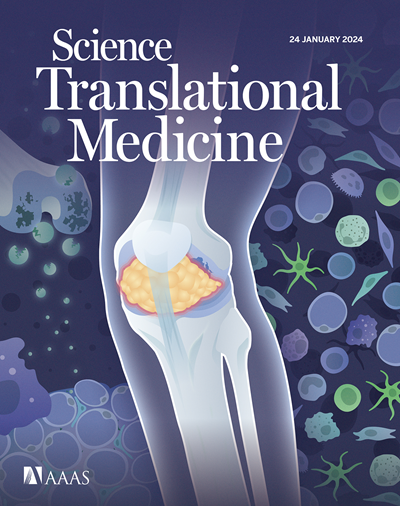Glp1r-Lepr coexpressing neurons modulate the suppression of food intake and body weight by a GLP-1/leptin dual agonist
IF 14.6
1区 医学
Q1 CELL BIOLOGY
引用次数: 0
Abstract
Glucagon-like peptide-1 (GLP-1) and leptin signal recent feeding and long-term energy stores, respectively, and play complementary roles in the modulation of energy balance. Previous work using single-cell techniques in mice revealed the existence of a population of leptin receptor (Lepr)–containing dorsomedial hypothalamus (DMH) neurons marked by the expression of GLP-1 receptor (Glp1r; LepRGlp1r neurons) that play important roles in the control of feeding and body weight by leptin. Here, we demonstrate the existence of a population of LepRGlp1r neurons in the DMHs of nonhuman primates (NHPs), suggesting the potential translational relevance of these neurons. Consequently, we developed a GLP-1R/LepR dual agonist and demonstrated the physiological activity of both components in vivo using leptin-deficient and Lepr-deficient murine models. We further found roles for LepRGlp1r neurons in mediating the dual agonist’s efficacy on food intake and body weight loss. Ablating Lepr in Glp1r-expressing neurons (LeprGlp1rKO mice) abrogated the suppression of food intake by the dual agonist. Furthermore, reactivation of Glp1r expression in Lepr neurons on an otherwise Glp1r-null background (Glp1rLeprRe mice) was sufficient to permit the suppression of food intake and body weight by the dual agonist. Hence, LepRGlp1r neurons represent targets for a GLP-1R/LepR dual agonist that potently reduces food intake and body weight.
Glp1r-Lepr共表达神经元通过GLP-1/瘦素双重激动剂调节食物摄入和体重的抑制
胰高血糖素样肽-1 (Glucagon-like peptide-1, GLP-1)和瘦素分别信号近期摄食和长期能量储存,在调节能量平衡中起互补作用。先前在小鼠中使用单细胞技术的研究表明,存在一群含有瘦素受体(Lepr)的下丘脑背内侧(DMH)神经元,其标志是GLP-1受体(Glp1r;LepR Glp1r神经元)通过瘦素在摄食和体重控制中发挥重要作用。在这里,我们证明了非人类灵长类动物(NHPs) DMHs中存在一群LepR Glp1r神经元,这表明这些神经元具有潜在的翻译相关性。因此,我们开发了GLP-1R/LepR双激动剂,并在瘦素缺乏和LepR缺乏的小鼠模型中证明了这两种成分的体内生理活性。我们进一步发现LepR Glp1r神经元在介导双激动剂对食物摄入和体重减轻的作用。在Glp1r表达神经元(Lepr Glp1r KO小鼠)中消融Lepr可消除双激动剂对食物摄入的抑制。此外,在Glp1r缺失的背景下(Glp1r Lepr Re小鼠),在Lepr神经元中Glp1r表达的再激活足以允许双重激动剂抑制食物摄入和体重。因此,LepR Glp1r神经元是GLP-1R/LepR双重激动剂的靶点,可以有效减少食物摄入和体重。
本文章由计算机程序翻译,如有差异,请以英文原文为准。
求助全文
约1分钟内获得全文
求助全文
来源期刊

Science Translational Medicine
CELL BIOLOGY-MEDICINE, RESEARCH & EXPERIMENTAL
CiteScore
26.70
自引率
1.20%
发文量
309
审稿时长
1.7 months
期刊介绍:
Science Translational Medicine is an online journal that focuses on publishing research at the intersection of science, engineering, and medicine. The goal of the journal is to promote human health by providing a platform for researchers from various disciplines to communicate their latest advancements in biomedical, translational, and clinical research.
The journal aims to address the slow translation of scientific knowledge into effective treatments and health measures. It publishes articles that fill the knowledge gaps between preclinical research and medical applications, with a focus on accelerating the translation of knowledge into new ways of preventing, diagnosing, and treating human diseases.
The scope of Science Translational Medicine includes various areas such as cardiovascular disease, immunology/vaccines, metabolism/diabetes/obesity, neuroscience/neurology/psychiatry, cancer, infectious diseases, policy, behavior, bioengineering, chemical genomics/drug discovery, imaging, applied physical sciences, medical nanotechnology, drug delivery, biomarkers, gene therapy/regenerative medicine, toxicology and pharmacokinetics, data mining, cell culture, animal and human studies, medical informatics, and other interdisciplinary approaches to medicine.
The target audience of the journal includes researchers and management in academia, government, and the biotechnology and pharmaceutical industries. It is also relevant to physician scientists, regulators, policy makers, investors, business developers, and funding agencies.
 求助内容:
求助内容: 应助结果提醒方式:
应助结果提醒方式:


